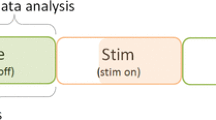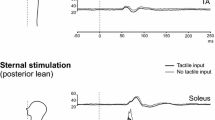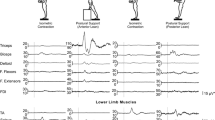Abstract
Our objective was to investigate the neural mechanisms and the functional relevance of motor effects that develop involuntarily following the release of a sustained isometric muscle contraction. The few data available in the literature deal only with post-contractions occurring in a body segment. Although these data emphasise the role of proprioceptive input, the question as to whether this phenomenon is of central or peripheral origin remains unclear. Given the leading role of neck muscle proprioceptive input in body orientation and posture regulation, we designed two experiments to test for postural posteffects after voluntary and involuntary neck muscle contraction. The spatiotemporal characteristics of the posteffects were analysed by means of stabilometric recordings following 30-s isometric contraction of splenius, trapezius and levator muscle groups, and 30-s electrically-induced contraction of the levator muscle group. Results show that a postural response occurred after voluntary contraction of each muscle group tested, which was oriented in the plane of action of the muscle, and lasted 14 min at least. In contrast, no clearly oriented body leanings were found after electrical stimulation of the levator muscle, except for a slight increase in natural postural instability. Data are interpreted as a change in the postural reference resulting from an increase in proprioceptive inflow accompanying mainly the voluntary muscle contraction.




Similar content being viewed by others
References
Burke D, Hagbarth KE, Lofstedt L, Wallin BG (1976) The responses of human muscle spindle endings to vibration of non-contracting muscles. J Physiol 261:673–693
Clement G, Lestienne F (1988) Adaptive modifications of postural attitude in conditions of weightlessness. Exp Brain Res 72:381–389
Craske B, Craske JD (1986) Oscillator mechanisms in the human motor system: investigating their properties using the aftercontraction effect. J Mot Behav 18:117–145
Cratty BJ, Duffy KE (1969) Studies of movement aftereffects. Percept Mot Skills 29:843–860
Decety J (1996) Do imagined and executed actions share the same neural substrate? Cogn Brain Res 3:87–93
Deiber M-P, Ibanez V, Honda M, Sadato N, Raman R, Hallett M (1998) Cerebral processes related to visuomotor imagery and generation of simple finger movements studied with positron emission tomography. Neuroimage 7:73–85
Dong C, Swindale NV, Cynader MS (1999) A contingent aftereffect in the auditory system. Nat Neurosci 2:863–865
Edin BB, Vallbo AB (1990) Muscle afferent responses to isometric contractions and relaxations in humans. J Neurophysiol 63:1307–1313
Eklund G (1972) General features of vibration-induced effects on balance. Ups J Med Sci 77:112–124
Gandevia SC (1985) Illusory movements produced by electrical stimulation of low-threshold muscle afferents from the hand. Brain 108:965–981
Ghafouri M, Thuillier F, Gurfinkel VS, Lestienne F (1998) Muscular after-contraction and ongoing postural reactions in standing and sitting humans. Neurosci Lett 250:61–65
Gilhodes JC, Gurfinkel VS, Roll JP (1992) Role of Ia muscle spindle afferents in post-contraction and post-vibration motor effect genesis. Neurosci Lett 135:247–251
Grasso R, Ivanenko Y, Lacquaniti F (1999) Time course of gaze influences on postural responses to neck proprioceptive and galvanic vestibular stimulation in humans. Neurosci Lett 273:121–124
Gregoric M, Takeya T, Baron JB, Bessineton JC (1978) Influence of vibration of neck muscles on balance control in man. Agressologie 19(A):37–38
Gregory JE, Morgan DL, Proske U (1988) Aftereffects in the responses of cat muscle spindles and errors of limb position sense in man. J Neurophysiol 59:1220–1230
Gurfinkel VS, Levick YS (1991) Perceptual and automatic aspects of the postural body scheme. In: Paillard J (eds) Brain and space. Oxford Science Publications, New York, pp 147–162
Gurfinkel VS, Levik YS, Popov KE, Smetanin BN, Shlikov VY (1988) Body scheme in the control of postural activity. In: Gurfinkel VS, Ioffe ME, Massion J, Roll JP (eds) Stance and motion. Plenum Press, New York, pp 185–193
Gurfinkel VS, Levik YS, Lebedev MA (1989) Immediate and remote postactivation effects in the human motor system. Neirofiziologiia 21:343–351
Head H, Holmes G (1911) Cerebral disturbances from cerebral lesions. Brain 34:102–245
Heide J, Molbech S (1973) Influence of after-movement on muscle memory following isometric muscle contraction. Ergonomics 16:787–796
Hollins M, Favorov O (1994) The tactile movement aftereffect. Somatosens Mot Res 11:153–162
Horak FB, Macpherson JM (1996) Postural orientation and equilibrium. In: Rowell L, Shepherd J (eds) Handbook of physiology. Section 12. Exercise: regulation and integration of multiple systems. Oxford University Press, New York, pp 255–292
Hutton RS, Smith JL, Eldred E (1973) Postcontraction sensory discharge from muscle and its source. J Neurophysiol 36:1090–1103
Kapandji IA (1994) Physiologie articulaire 3, tronc et rachis. Maloine, Paris
Karnath HO (1995) Transcutaneous electrical stimulation and vibration of neck muscles in neglect. Exp Brain Res 105:321–324
Karnath HO, Christ K, Hartje W (1993) Decrease of contralateral neglect by neck muscle vibration and spatial orientation of trunk midline. Brain 116:383–396
Karnath HO, Reich E, Rorden C, Fetter M, Driver J (2002) The perception of body orientation after neck-proprioceptive stimulation. Effect of time and of visual cueing. Exp Brain Res 143:350–358
Kavounoudias A, Roll R, Roll J-P (1998) The plantar sole is a ‘dynamometric map’ for human balance control. Neuroreport 9:3247–3252
Kavounoudias A, Gilhodes JC, Roll R, Roll JP (1999) From balance regulation to body orientation: two goals for muscle proprioceptive information processing? Exp Brain Res 124:80–88
Koenig E, Dichgans J (1981) Aftereffects of vestibular and optokinetic stimulation and their interaction. Ann NY Acad Sci 374:434–445
Kohnstamm O (1915) Demonstration einer Katatonieartigen Erscheimung beim Gesunden (Katatonusversurch). Neurol Zentralbl B1 34S:290–291
Lacôte M, Chevalier A-M, Miranda A, Bleton J-P (1993) Evaluation clinique de la fonction musculaire, 2eme édition. Maloine, Paris
Massion J (1998) Postural control systems in developmental perspective. Neurosci Biobehav Rev 22:465–472
Ribot-Ciscar E, Tardy-Gervet MF, Vedel JP, Roll JP (1991) Post-contraction changes in human muscle spindle resting discharge and stretch sensitivity. Exp Brain Res 86:673–678
Ribot-Ciscar E, Roll JP, Gilhodes JC (1996) Human motor unit activity during post-vibratory and imitative voluntary muscle contractions. Brain Res 716:84–90
Ribot-Ciscar E, Rossi-Durand C, Roll JP (1998) Muscle spindle activity following muscle tendon vibration in man. Neurosci Lett 258:147–150
Rogers DK, Bendrups AP, Lewis MMcD (1985) Disturbed proprioception following a period of muscle vibration in humans. Neurosci Lett 57:147–152
Roll JP, Roll R (1987) Extraocular proprioception as an element of postural reference and spatial coding of retinal information. Agressologie 28:905–12
Roll JP, Roll R (1988) From eye to foot: a proprioceptive chain involved in postural control. In: Amblard B, Berthoz A, Clarac F (eds) Posture and gait: development, adaptation and modulation. Excerpta Medica, Amsterdam, pp 155–164
Roll JP, Vedel JP (1982) Kinaesthetic role of muscle afferents in man, studied by tendon vibration and microneurography. Exp Brain Res 47:177–190
Roll JP, Vedel JP, Ribot E (1989) Alteration of proprioceptive messages induced by tendon vibration in man: a microneurographic study. Exp Brain Res 76:213–222
Roll R, Gilhodes JC, Roll JP, Popov K, Charade O, Gurfinkel V (1998) Proprioceptive information processing in weightlessness. Exp Brain Res 122:393–402
Roll R, Kavounoudias A, Roll J-P (2002) Cutaneous afferents from human plantar sole contribute to body posture awareness. Neuroreport 13:1957–1961
Sapirstein MR, Herman RC, Wallace GB (1937) A study of aftercontraction. Am J Physiol 119:549–556
Smetanin BN, Popov KE, Yu-Shlifov B (1993) Postural response to vibratory stimulation of human neck muscle proprioceptors. Neirofiziologiia 1:101–108
Vallar G, Rusconi ML, Barozzi S, Bernardini B, Ovadia D, Papagno C, Cesarani N (1995) Improvement of left visuo-spatial hemineglect by left-sided transcutaneous electrical stimulation. Neuropsychologia 33:73–82
Vallbo AB (1974) Human muscle spindle discharge during isometric voluntary contractions. Amplitude relations between spindle frequency and torque. Acta Physiol Scand 90:319–336
Vedel J-P, Roll J-P (1983) Muscle spindle contribution to the coding of motor activities in Man. Exp Brain Res Suppl 7:253–265
Verschueren SM, Cordo PJ, Swinnen SP (1998) Representation of wrist joint kinematics by the ensemble of muscle spindles from synergistic muscles. J Neurophysiol 79:2265–2276
Wierzbicka MM, Gilhodes JC, Roll JP (1998) Vibration-induced postural posteffects. J Neurophysiol 79:143–150
Wilson LR, Gandevia SC, Burke D (1995) Increased resting discharge of human spindle afferents following voluntary contractions. J Physiol 488:833–840
Zar JH (1996) Biostatistical analysis. Prentice Hall, Upper Saddle River NJ
Acknowledgements
This work was supported by Centre National de la Recherche Scientifique (CNRS) and Centre National d’Etudes Spatiales (CNES) grants.
Author information
Authors and Affiliations
Corresponding author
Rights and permissions
About this article
Cite this article
Duclos, C., Roll, R., Kavounoudias, A. et al. Long-lasting body leanings following neck muscle isometric contractions. Exp Brain Res 158, 58–66 (2004). https://doi.org/10.1007/s00221-004-1871-8
Received:
Accepted:
Published:
Issue Date:
DOI: https://doi.org/10.1007/s00221-004-1871-8




